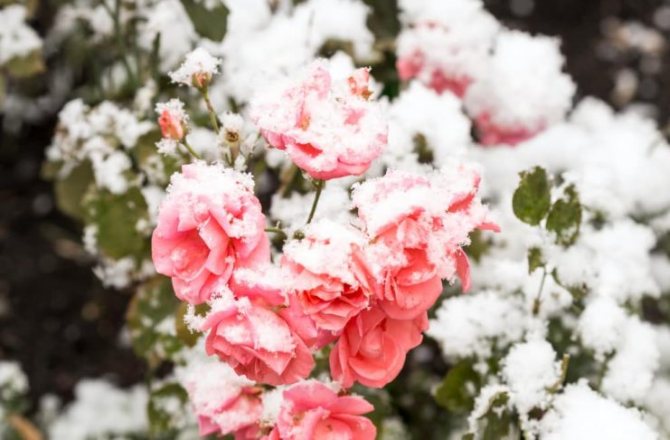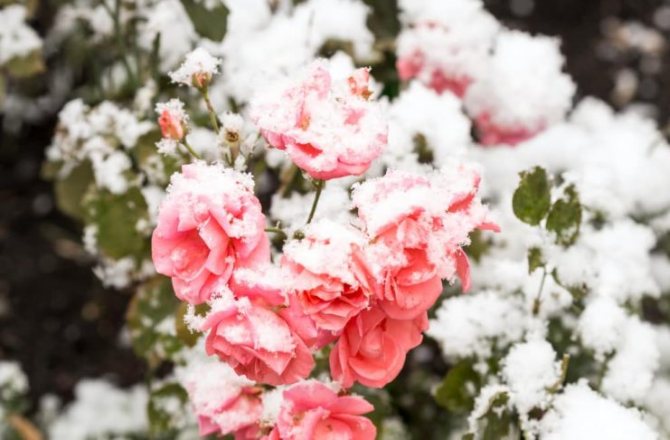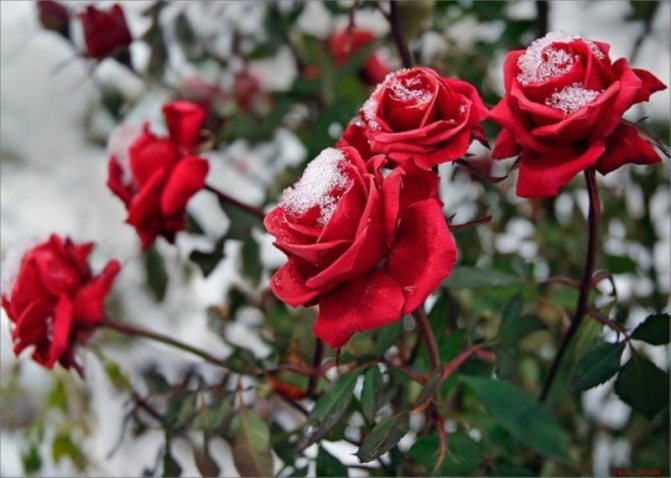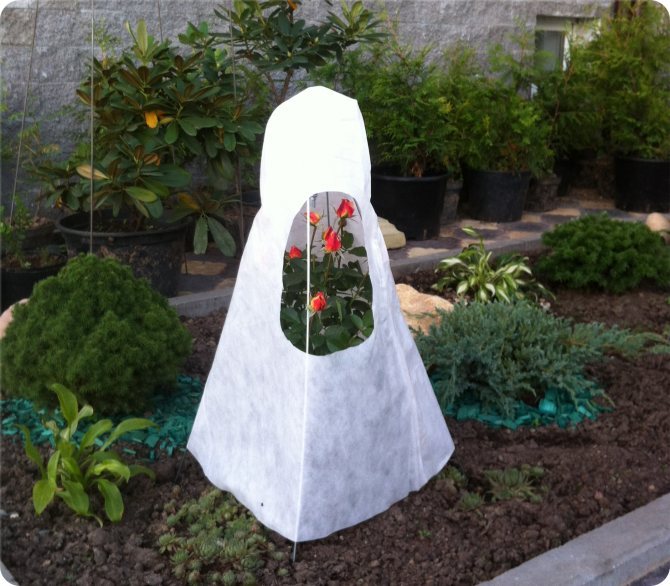Roses are some of the most beautiful flowers, but they are very moody and require special care. The winter period of time is the most problematic for them, because this season it is necessary to take care of protection for the flowers so that they do not die from frost or do not get locked up due to the fact that gardeners provided them with improper care.
Many give their roses proper care, and many have little understanding of what is best to do to protect the flowers. Therefore, below I will tell you about how best to protect roses from frost, and about what kind of frost roses can withstand without shelter. This is very important to understand in order to provide plants with the correct shelter that will protect them, not harm them.

Below are key facts about roses and how they handle the cold. This information should be used by both novice gardeners and professionals with extensive experience, because it will greatly facilitate the work and help keep the roses in good shape.
Frosts that do not require shelter
Many gardeners are interested in what temperature roses can survive without shelter. This is not a myth, there really are frosts that plants are quite capable of surviving without providing additional protection. These include:
- very slight frosts that harden the shoots;
- more severe frosts (up to -15 degrees of frost), if they are not very long-term.
In the presence of such frosts, in no case should you provide roses with full-fledged protection, because in this case there is a high risk of rotting and death of plants.
What Happens to Roses when the Cold Falls
To obtain the decorative effect expected from roses, they must be carefully covered during the cold season. Without this, roses can die.
Selection roses do not have the ability, like other perennial shrubs, to enter dormant in winter. They meet the cold weather with new young shoots and flower buds. Frost forces the plant to enter a dormant period forcibly. But this state is in no way reminiscent of the hibernation of other shrubs. Slightly the temperature rises above zero, the rose immediately resumes sap flow and continues the growing season. This feature is the main reason for the death of roses in winter.
Roses, in principle, can withstand frosts down to -6 ° C and even a short-term drop in temperature to -12 ° C. But the juices in the plant freeze at a temperature of -3oC. They turn into ice, which breaks the tissue of the shoots, forming microcracks in them. Old shoots, unlike young immature ones, are not afraid of these cracks (frost cracks) (which is why, before wintering, young shoots of this year on roses must be cut off). But these cracks are a very vulnerable place for pathogenic bacteria to enter the shoot. As soon as the temperature reaches zero, sap flow begins, bacteria are activated, penetrate the plant and infect it.
Infection will not occur only if the roses are covered, the shelter will be dry and there will be no temperature changes until spring, until the time when the shelter from the roses must be removed.
Ways to protect plants from frost
These plants are very fond of heat and therefore they need to provide quality protection from cold weather. There are many options for providing such protection, but two key groups can be distinguished:
- hilling and warming roses with a layer of dry leaves, spruce branches, sawdust and so on;
- hilling roses and air-dry frame shelter.
Here are some helpful tips to keep in mind when protecting your plants:
- Preparing plants for winter should be done in advance, this will allow the shoots to ripen well.
- When the second half of the summer season comes, it is worth moderating the frequency of watering, loosening the soil, and also reducing the amount of fertilizers containing nitrogen, because there will be no particular benefit from them, but they are capable of causing harm.
- Shelter materials should also be prepared well in advance and stored in a warm place until they are actually needed to protect the roses.
- When frosts of medium strength come, it is necessary to pour a layer of sand to the base of the bush and huddle the bush with earth for shelter (to a height of 10 to 40 cm, depending on the growth of the bush). Important! This should be done without fail, as otherwise frost will severely damage the shoot tissues.
- When the top of the soil is significantly frozen, you will need to make a full cover of the roses. Important! In addition, it is worth treating the bush with a 3% solution of iron-type vitriol, this will avoid various pests and the development of diseases for the bush. If this is not done, then the risk of the disease is extremely high.
- Bush roses must be pruned before covering. Important! Shoots must remain at least 30 cm. In addition, care must be taken to ensure that there are no unripe type shoots and their leaves. All these elements must be removed and must be burned.
- To protect roses, it is best to cover their spruce branches (it protects against many diseases and scares off mice, which can also damage the plant) and top up with insulating material.
- It is recommended that the stems of the bush be carefully tied to each other with a synthetic-type cord and bent to the ground before long frosts set in. This avoids the cracking of the plant bark. Important! Do not use cords that absorb moisture, as they can cause various diseases in plants.
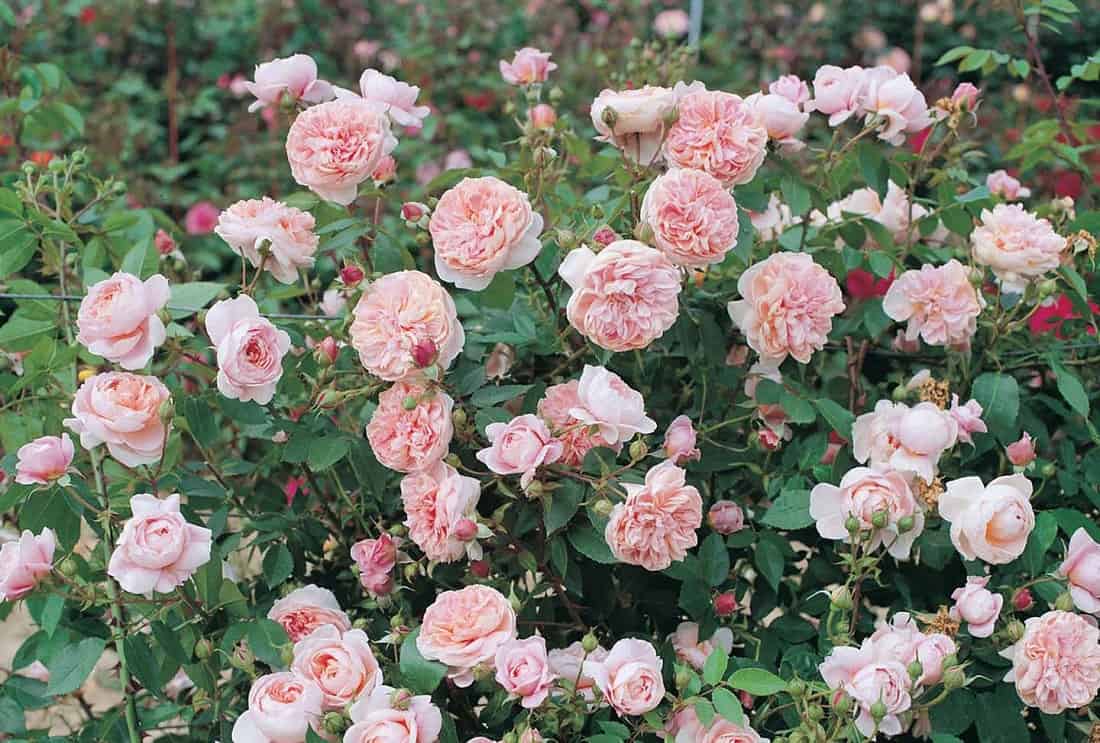

Shelter of rose and semi-climbing type
Such roses without shelter run the risk of suffering in the fall, therefore, to protect them, you must do the following:
- remove the stem part from the support. Important! If there are a lot of stems (more than 12), then it is necessary to remove all shoots that are more than three years old. They are already old and rather burden the bush than bring anything positive to it;
- tie the shoots to each other and lay them on the base of the bush (it should be huddled and covered with spruce branches) or bend them to the side and fix them in a tilted position at an angle, and stick wooden-type stakes into the ground. Important! All this work must be carried out extremely carefully so as not to harm the bush.
After that, roses of this type will surely survive any frost without any problems.
Shelter of standard roses without leaves
To protect this type of roses, you must do the following:
- untie the plant from the peg of the support type;
- dig in with earth from the part where the tilt of the trunk will be performed, tilt it slightly and bend it to the ground;
- fix with stakes, staples and spears;
- overlay the trunk with spruce branches and fix it with a cord;
- Sprinkle the bush and crown with earth.
Having completed all these works carefully, you will provide your roses with good protection from all the cold weather that awaits them in the winter.
Air dry shelter
This is a special type of shelter, in which over the bushes, for which hilling was carried out during the period of low frosts, for a couple of centimeters they install specialized frames (metal or wooden type, others are not recommended to be used, since they are not sufficiently reliable, and in some cases they can lead and to various diseases).A covering-type material is stretched on them and then a polyethylene film is placed, which provides a high level of protection.
This type of shelter is very good in that it creates a favorable microclimate for plants in winter and protects the bushes not only from a wide variety of cold weather, but also from high humidity.
Important! However, it should be borne in mind that this type of shelter can lead to damping of plants if condensation accumulates in damp areas under such a shelter. This will quickly ruin the flowers. In this situation, it is better to prefer a shelter with hilling and subsequent shelter with a layer of insulating materials, since it is safer for roses.
How to cover roses
You need to take care of the shelter of roses in advance, back in the middle of autumn. After all, the weather this season is unpredictable, and a small minus can come suddenly. The creation of a shelter should be done during a period when the temperature does not drop below zero during the day, and there are no night frosts yet. In central Russia, the most suitable season for such work is October.


First you need to free the foliage from the shoots and cut them off. Then, over the bush, you need to create a shelter in the form of a house from wooden shields. From above it must be covered with polyethylene film. The ends should be left open until November.
In November, the end parts need to be nailed up with plywood, and then covered with foil. This will protect the roses from the penetration of snow and moisture into the house. During thaws, the ends should be opened. It is possible to completely remove the shelter only in the spring, when stable above-zero temperatures are established and there will be no night frosts.
If you do not have the opportunity to make a shelter out of wood, then you can build a wire frame around the bush, and then close it with fiberglass. Use leaves and spruce branches to mulch the soil under the bush.
conclusions


There are frosts that do not require additional measures to ensure the protection of the roses. With them, you can not provide roses with protection or get by with the most minimal protection measures. This can be done when very light frosts or rather severe frosts of a short-term nature are observed.
In all other cases, plants need to be provided with good shelter, otherwise they may suffer. When providing shelter, you should be careful, because if you approach this issue the wrong way, you can face the problem of decaying flowers, which will lead to their death. In order to avoid all this, you must follow the rules described above. Then your favorite flowers will be safe every year, they will not be afraid of winter at all.
Covering bush roses
Bush roses begin to warm around the beginning of October. However, this must be done before the first frost occurs. It is necessary to clearly define the period when the plants should be covered. The earliest frosts are not very scary for roses, because they help to harden them. To prepare for the procedure, follow these steps:
- remove all leaves, as well as shoots that are soft and grassy;
- the bushes themselves should be cut to a height of 30-40 centimeters and subjected to special treatment with antifungal agents.


After preparation, you can use several ways to protect the plant from frost. One of them is to build a hut for each bush. The design is very simple, and for this a couple of boards may be suitable, which must be hammered together in the form of a hut. From above, such a structure is covered with a film. This method is quite convenient, because in warm weather you can always open the film and ventilate the plant.
Another way is to sprinkle and huddle the bottom of the bush.It can be sprinkled a little with earth or mulch. On the mound that turned out during the process, you can lay spruce branches or dry foliage.
There is also an air-dry method. With this method, it is assumed that those bushes are insulated that are of particular value and are sold. In this case, the bush can be cut off completely. Or the shoots are placed on the ground and secured with metal staples. Then they are covered with spruce branches, spruce needles or dry leaves. You should install small pegs around the perimeter and cover the plants with mats, lay a film on top, which will need to be fixed. In this case, one edge must be left open so that ventilation can be carried out periodically.
Is it possible to cut roses in frost. Removing excess foliage
This seemingly superfluous at first glance artificial measure, firstly, is determined by the need to prepare plants for a state of seasonal dormancy. Secondly, it is a sanitary measure against the appearance in the mass of not completely fallen leaves of a favorable environment for rot and the development of harmful microbes and fungi. Thirdly, in the autumn crown of the rose there are already many leaves damaged by black spot or other infections.


By cutting off excess and defective leaves, we prevent future seasonal problems associated with common rose diseases, and we make the process of wintering under cover safe and successful. Dispose of cut leaves by burning, giving no chance of spreading spores, microbes and viruses in the next season or significantly reducing their impact.
It's important to know! In no case should you pick off excess leaves, which leads to injury to future buds and shoots, but cut them off with a clean and very sharp pruner or scissors, for convenience, folding them into the trash can immediately. It is imperative to cut off underdeveloped inflorescences and fruits, thereby excluding their rotting under cover.
If you have several bushes, and among them are climbing or a whole rose garden, then such a preparation measure becomes too burdensome and almost impossible to do. Here it is important to distribute forces and not to postpone the pruning of leaves for one pass, starting from September to do this sanitary pruning in a dosage manner. If it is not possible to cut off all the leaves in full under the conditions of your rose garden, then first of all you need to limit yourself to cutting out defective or diseased leaves. Spray those leaves that you do not have time to cut with Bordeaux liquid, copper or iron vitriol, as well as the Maxim fungicide. Treat the soil around the bushes with ash.
Misconception 6: spruce branches are the best material for sheltering roses
Lapnik is quite difficult to get the right amount, especially if you have a large rose garden. In order not to receive a fine, you will have to go to the leshoz, find out about the planned deforestation and ask them to pick up the unnecessary spruce branches.
To avoid this hassle, it is easier to cover the roses with non-woven material (spunbond) or roofing material. But it is better not to use plastic wrap: it disrupts moisture and air exchange.
Protect garden flowers from frost correctly - and then the rose garden will delight you with lush buds every year.
Misconception 5: all roses need to be spilled for the winter
Hilling roses for the winter has not only advantages, but also disadvantages. During thaws, the bush can support, and if then frosts come abruptly, then the bark of the plant runs the risk of cracking. Therefore, only self-rooted roses grown from cuttings need compulsory hilling. After all, their root system is very afraid of the cold.
In nurseries, roses are usually sold grafted onto rose hips. Such plants tolerate cold better, so they do not need to be hilled. But keep in mind: if the rose is not planted deeply enough, and the grafting site is above the soil surface, then you cannot do without hilling.For this, a dry substrate is used: peat, garden soil or sand. If the grafting site is deepened by more than 4 cm, then you will not notice the benefits of hilling.
Misconception 2: the warmer the shelter for roses, the better
Plants are well protected from the cold not by the non-woven material itself, but by the air gap between the bush and the shelter. Also an excellent insulation is a thick layer of snow. Therefore, the warmest shelter for roses is a solid frame (which will create a large cushion of warm air), covered with a white spunbond with a density of 60 g / m2, and on top of it - with snow.
The shelter frame can be built from wooden poles or boards, perforated plywood boxes, tall plastic vegetable boxes. Or buy a ready-made frame made of polymer tubes in a garden store.
What frosts do roses withstand in spring. Spring is the time for pruning roses, they are not afraid of frost
Ant ale
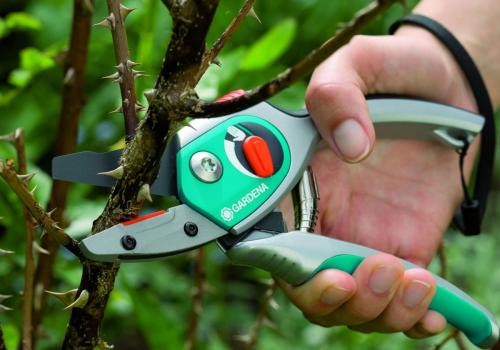

The question of how to properly prune roses after winter is of interest to many flower growers. Pink shoots delight with flowers for several years and then die off. It is from the upper part of the stem that dying occurs, and new shoots begin to grow from the buds that are located a little lower.
If the rose bush is not cut off for several years, then its stems will simply intertwine and the rose will begin to lose its beauty. Also, an uncut plant becomes an object of pests and a breeding ground for diseases that will affect other bushes in the rose garden.
Correct pruning of roses is the key to health and lush flowering
What you need to know about properly pruning rose bushes after winter? In the spring, as soon as the buds swell, it's time to start pruning. But do not rush, so as not to wake up the plants ahead of time. They will suffer from spring frosts and will not bloom in summer. And there is no need to delay. This will lead to the fact that the bushes will weaken and not give a lush bloom. You need to cut roses correctly on time and do not do this during the period of sap flow.
When to prune roses
You need to cut roses in the spring before April 15, when the bush begins to grow. Only the longest stems are cut in late spring. In summer - damaged shoots and faded buds. If they are not removed, they get wet and rot in rainy weather.
In the fall, they must inspect the bushes and cut off the buds, fruits and long shoots that risk being broken in winter. This applies to sick and dry shoots. The rose bush is shaped.
Ways to prune roses in spring
For the procedure you will need:
- tight clothing and gloves that protect the body from sharp thorns;
- garden knife;
- secateurs.
To properly prune roses in the spring, there are four basic pruning methods you need to know.
"Classical"
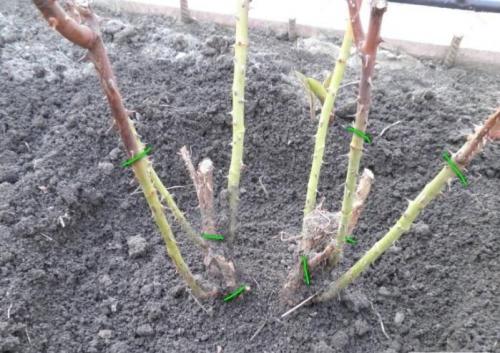

This is the main way for gardeners. First, the bush is examined, and dead stems are removed to the base. The color of the wood on the cut is light and without brown tints. Thin twigs and root shoots are pruned without regret. Healthy stems are slightly shortened.
"Moderate"
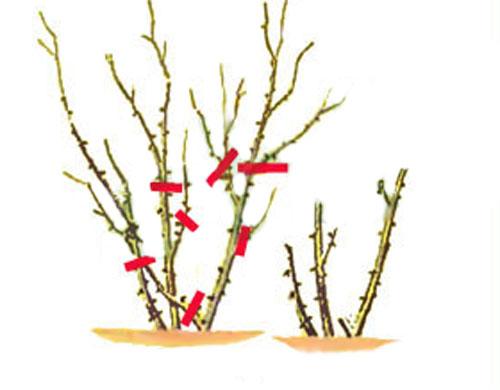

The method is applied to bush roses and standard tea-hybrid roses, as well as kfloribunda. The stems of the bushes need to be cut in half. As for the weakened shoots, they are cut off or removed altogether. Shoots cannot be broken. They are cut only with a sharp secateurs.
"Easy"
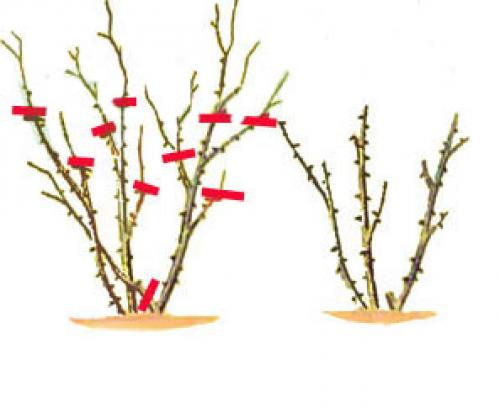

This pruning method is applied to rooted and vigorous varieties of hybrid tea roses. Shoots are cut at only two-thirds of the height. The method is not recommended as an annual one. This will lead to stretching of the shoots and poor flowering of the roses.

